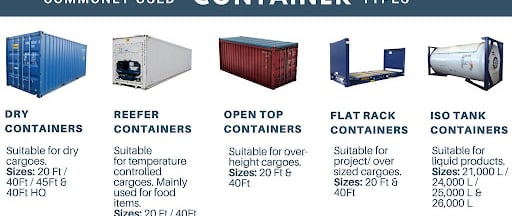Explore different types of container & their sizes
Understanding Different Types and Sizes of Containers: A Comprehensive Guide
8/21/20243 min read


Understanding Different Types and Sizes of Containers: A Comprehensive Guide
Containers serve an increasingly important role in businesses that rely on logistics, transportation, and storage efficiency. Understanding the various kinds and sizes of containers can be quite helpful when shipping products abroad or arranging your personal possessions. To assist you in making wise judgments, let's explore the world of containers and all of their shapes and sizes.
1. Shipping Containers
a. Standard Shipping Containers
20-feet container: This is the most popular size and is also known as a TEU (Twenty-foot Equivalent Unit). It is quite adaptable and usually used for smaller shipments. Its measurements are about 8.5 feet high, 8 feet broad, and 20 feet long.
40-foot container: It is twice as long as a 20-foot container and is another type of TEU. It is frequently used in international trade and is perfect for larger shipments. About 40 feet long, 8 feet broad, and 8.5 feet high are the dimensions.
40-Foot High Cube Container: This container has a height of one foot (9.5 feet total) and is the same length as a conventional 40-foot container. More capacity is available for heavier items.
b. Specialized Shipping Containers
Reefer containers: These are cold storage units intended for the transportation of perishable commodities. They have a cooling system to maintain a certain temperature, and they come in different sizes, usually 20 or 40 feet.
Open Top Containers: Used for big freight that does not fit through ordinary doors, these containers feature a removable top. They are frequently used for items like machinery or huge equipment that must be loaded from the top.
Flat Rack Containers: Basically a foundation without any sides or top, flat racks are perfect for heavy and huge goods since they make it simple to load and unload big objects like machinery and cars.
2. Storage Containers
a. Storage Containers
Portable Storage Units: These are frequently used for relocation or temporary storage purposes. While sizes might vary, 8x8x16 feet or 10x10x20 feet are typical measurements. They can be transported to your location and are convenient for on-site storage.
Repurposed cargo containers: They are a common choice for individual storage needs. They are available in two common sizes (20 feet and 40 feet) and offer a safe, weatherproof way to store tools, equipment, or personal belongings.
b. Modular Storage Containers
Storage Pods: You can keep personal belongings in these smaller, modular containers. They are made to be flexible and simple to use, and they typically come in sizes like 8x8x10 feet.
3. Industrial Containers
a. Bulk Containers
IBC Totes: Used for bulk liquid or granular products, Intermediate Bulk Containers (IBC) are sizable, pallet-sized containers. Their capacity ranges from 275 to 330 gallons, and they are composed of sturdy materials such as metal or plastic.
Bulk bags: These are big, flexible bags that are used for storing and moving bulk items like grains, powders, or chemicals. They are also referred to as FIBCs (Flexible Intermediate Bulk Containers). They have a 2,000 pound capacity.
b. Drum Containers
Metal drums: Made of steel or plastic, these barrels are commonly used for industrial or hazardous products. They are available in quantities up to 55 gallons (210 liters). Their design prioritizes robustness and ease of use.
Plastic drums: They are lighter and more corrosion-resistant than metal drums, yet they nevertheless serve the same purpose. They are available in many capacities, often ranging from 15 to 55 gallons, and are utilized for a range of non-hazardous products.
4. Custom and Specialty Containers
a. Customizable Containers
Customized Shipping Containers: A lot of companies and people alter shipping containers to build distinctive environments like residences, offices, or pop-up stores. These changes may involve doors, windows, insulation, and other elements.
Modular Containers: Suitable for everything from temporary offices to modular classrooms, these containers may be joined to form larger areas or bespoke design.
b. Specialty Containers
Insulated containers: These are made to withstand extremely high or low temperatures and shield delicate cargo. They are frequently utilized in electronics or pharmaceuticals.
Explosive Storage Containers: With reinforced walls and cutting-edge locking systems, these containers are made expressly to safely store and transport explosive goods.
Conclusion
There is a vast range of sizes and types of containers available, each designed to meet particular requirements and purposes. Selecting the appropriate container can improve productivity, safety, and cost-effectiveness. Standard shipping containers promote international trade, whereas specialized containers are used in industries. Choosing the right container is essential to reaching your objectives, whether you're organizing a supply chain or clearing out your house.
